Indoor Flies and Their Control
By: Michael Merchant
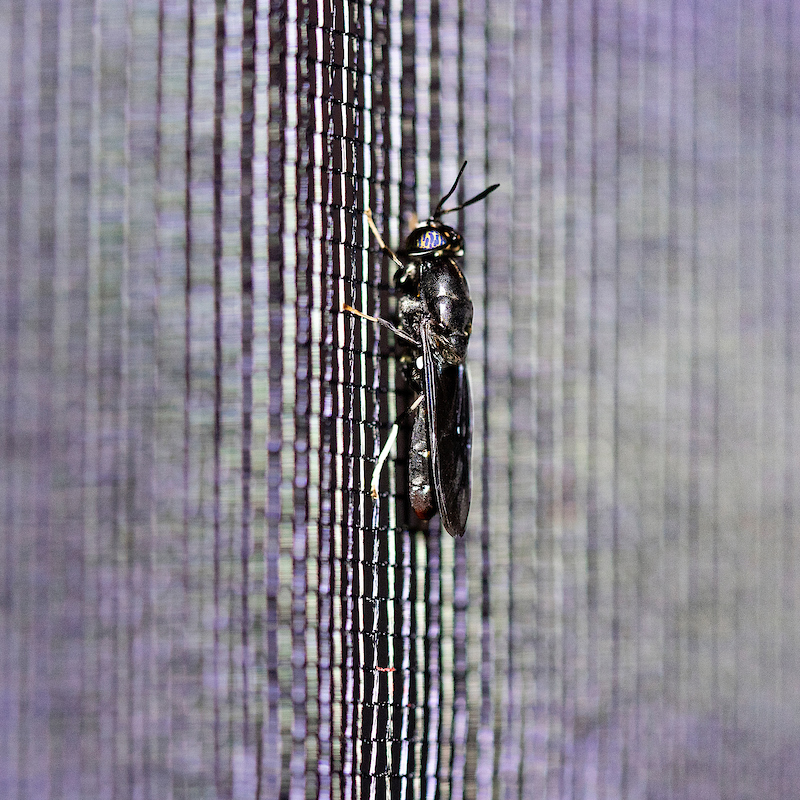
Most homes and businesses eventually experience problems with indoor flies. Though relatively few kinds of flies can breed and complete their life cycles inside a structure, each indoor fly species is unique. For that reason, it’s important to correctly identify the type of fly in your home in order to control it.
Flies are one of the largest groups of insects. Unlike most other winged insects, which have four wings, flies have only two. This difference distinguishes them from nearly all other insect orders.
All flies go through complete metamorphosis—egg, larva, pupa and adult. These stages of development allow flies to take advantage of different breeding and living sites. Fly eggs and larvae, for example, are not highly mobile and are generally found in moist or watery environments. Adults, on the other hand, are highly mobile—they can fly and locate food in wet or dry environments. Because they can fly, adult flies can find even temporary food sources quickly, before they disappear. Immature flies (larvae) are legless and may live in drains, standing water, rotting foods, potting soil, or garbage.
Smaller house-infesting flies include drain flies, fruit flies, phorid flies, and fungus gnats. Larger flies, such as blow flies and flesh flies, occasionally invade homes to lay eggs on a decaying carcass. These flies rarely infest homes for long. House flies and mosquitoes rarely breed inside structures; however, they readily take advantage of open doors or unscreened windows to get indoors for food or shelter.
Insecticides alone are rarely successful in eliminating indoor fly infestations. Fly control is most effective when breeding sites in the structure are identified and eliminated. Because each type of indoor fly prefers slightly different breeding sites, identifying the fly should be the first step in any control effort. The following are descriptions of the most common indoor flies along with explanations of how to locate and eliminate their breeding sites.
Small indoor flies
Small house-infesting flies are generally less than 1/8 inch (4 mm) long as adults. All of the following flies are capable of breeding and living entirely indoors. These flies, however, are also found outdoors and may enter through open windows or doors.
Fruit flies
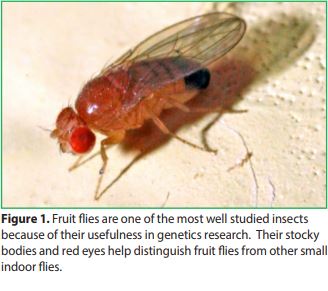
Fruit flies (Family Drosophilidae) are common indoors and out. Infestations are most frequent during the summer when fruit flies are active outdoors—though indoor infestations are possible any time of year. Fruit flies are approximately 1/8 inch long (2 to 4 mm) with a stout, cylindrical body. They usually have reddish eyes. They are small enough to pass through window screens and can easily enter through open doors or windows. They can be distinguished from other small indoor flies by the feathery bristle (arista) on the tip of their third antennal segment.
Drosophila fruit flies are used widely in genetics research because of their ability to reproduce quickly. Under optimum conditions, the life cycle of a fruit fly can complete in as few as 8 days.
Fruit flies are sometimes referred to as vinegar or pomace flies because they are attracted to vinegar and almost any decaying fruit. There are more than 170 species of fruit flies in the U.S. and Canada. Their food preferences can vary, but these flies will breed in almost any fermenting fruit or vegetable. They are also commonly found in spilled syrups, wine, or beer—especially in moist places, such as under commercial kitchen equipment, bars, soft drink dispensers, and in cracked tile or flooring. In homes, breeding is more common in overripe or damaged fruits (especially bananas) and spoiling vegetables such as rotting onions or potatoes. The larvae feed on yeasts associated with the decay of these materials.
Common fruit fly breeding sites
- Trash receptacles, especially the wet bottoms of trash cans when plastic liners have leaked
- Bags of vegetables, such as potatoes or onions, in pantries
- Damaged or overripe bananas, pineapples, strawberries, tomatoes or other fruits left out of the refrigerator
- Spillage or vegetable debris under salad bars, soft drink dispensers, or around alcohol bars
- Open or loose lids on vinegar, wine, beer, or cider containers
- Recycling bins with unrinsed wine, beer, or soda containers
- Damp, dirty mops, brooms, or cleaning rags
- Crevices in floors of commercial kitchens, especially underneath cracked or damaged tile
- Any kind of moist rotting or fermenting organic matter
- Floor drains and urinal areas
- Grocery store repackaging areas where damaged food boxes are kept
Fruit flies with black eyes, known as dark-eyed fruit flies, breed more frequently in drains, around bathrooms and urinals, and even in rotting cacti.
Fruit flies do not bite, but most people consider them annoying. In hospitals, they are considered a public health risk because of their potential for contaminating sterile surfaces. In addition to bacterial contamination, ingestion of fruit fly-infested food has been reported to cause intestinal upset, diarrhea, or intestinal myiasis. Health departments consider fruit flies in restaurants or other food service businesses to be unsanitary.
Fruit flies can be controlled by taking out the trash or removing unrefrigerated, overripe fruit, or rotting vegetables. Locating and eliminating other breeding sites can sometimes be more challenging. Using traps or sprays may provide temporary relief from fruit flies, but eliminating the breeding site is essential for complete control.
Phorid flies
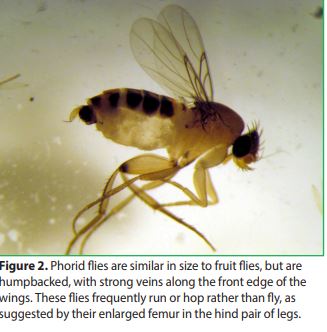
Phorid flies (Family Phoridae) are another fly found in homes and, even more commonly, in commercial buildings. They are approximately the same size as fruit flies (1/8 inch, 2 to 4 mm) but have a hump-backed appearance. They are tan to dark-brown or black. Phorid flies have dark veins along the front edge of their wings. The veins in the central part of the wings are almost parallel and lack the linking cross veins seen in most other fly wings. Phorid flies have enlarged femurs on the third pair of legs, which make them good runners. They often run and stop repeatedly before taking wing, giving them another common name, “scuttle fly.”
The phorid fly’s life cycle, from egg to adult, takes 14 to 37 days, depending on conditions. Eggs are laid on or beside moist decaying materials.
Phorid fly larvae feed on a variety of decaying plant and animal matter. They are found in any type of moist, decaying material including: decomposing animal carcasses, garbage, drain pipes, flowers in vases, wet potted plant soil, garbage cans, broken garbage disposals, dung, feces, and fungi. Because phorid flies come from such unsanitary breeding sites, their presence around kitchens and in sterile areas is highly undesirable. Having a few phorid flies indoors is not unusual, but large numbers of them usually indicate unsanitary conditions.
Phorid flies have an amazing ability to penetrate soil to locate breeding sites. They can even penetrate six feet or more of soil to infest caskets, earning them still another common name, the “coffin fly.” Phorid flies are frequent pests in cemeteries and mausoleums where they develop in liquid wastes associated with decay.
Another underground source of phorid flies is soil that has been contaminated by leaks around sewer lines. When such leaks occur under buildings, they can lead to severe indoor fly infestations and sometimes require expensive excavation to remove the contaminated soil.
Drain flies
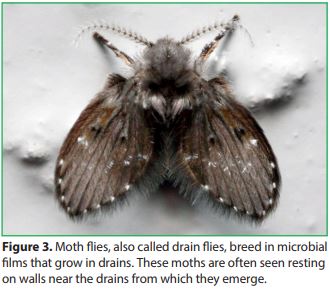
Drain flies (Family Psychodidae) are also called moth flies because of their fuzzy, moth-like appearance. They are dark gray to black and found near sinks and tubs.
Adult drain flies are small (1/16 to 1/5 in, 2 to 5 mm), greyish, and densely covered with hairs. They hold their broad wings either flat or like a roof over the body at rest. Drain flies usually fly only a few feet at a time.
Females lay masses of 20 to 100 eggs, which hatch in less than 48 hours into small (up to 3/8 in, 4 to 10 mm), legless larvae. These larvae are brown, sometimes pale in the middle and darker on the ends, and may look banded. The larval stage lasts 8 to 24 days and the pupal stage 1 to 2 days. Adults may live as long as 2 weeks.
Drain fly larvae and pupae live in the thin microbial films often found in drains, underground septic tank field lines, and on filter stones in wastewater treatment plants. Drain flies feed on algae, bacteria, fungi, and other microscopic organisms associated with the film. Indoors, drain flies can breed in floor or sink drains, air conditioner and refrigerator condensate pans, bottoms of garbage cans, under broken or cracked tile, in tracks of sliding glass doors, in wet cracks in the floor, or around dirty floor drains.
Fungus gnats
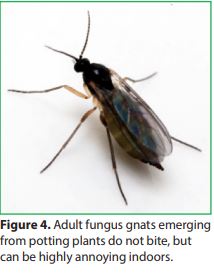
Fungus gnats (Families Mycetophilidae and Sciaridae) are very small (1/16 to 1/8 in, 1.5 to 3 mm), slender flies with clear or dark wings. They are mosquito like, with long slender legs and bead-like antennae—though much smaller than mosquitoes. Also, unlike mosquitoes, fungus gnats do not bite, though they can be a nuisance when flying around one’s face or in front of a computer screen.
Fungus gnat larvae (1/4 in, 6 mm) live in moist locations such as potting soil. They are white, legless and slender, and have shiny black head capsules. These larvae feed on the roots of plants or on fungi growing in potting soil. They are most likely to emerge from the potting media of houseplants, although some types may also feed on microbial films in drains, similar to drain flies. In some cases, infestations of potted plants occur when one uses soil from a batch that was infested from storage or from the manufacturer.
Infestations from potted plants can be eliminated by moving the pots outdoors. These infestations are most common during the winter months, when over- watering is more common. When plants cannot be removed, you can suppress an infestation by watering less frequently so that potting soil has a chance to dry out. However, once fungus gnats become a problem, just reducing moisture may not provide satisfactory control. In such cases, the pot and soil should be treated with an insecticide or replaced.
Indoor insecticide sprays or fogs may provide temporary relief from fungus gnat infestations, but they will not solve the problem. The only way to get rid of fungus gnats is to find and eliminate the breeding sites.
Large indoor flies
The following flies are generally more than 1/4 inch long as adults. These larger flies are found principally outdoors, but can also become indoor pests. House flies rarely breed indoors, but may enter through open windows or doors. The soldier fly and the carrion breeding flies may breed indoors when an animal dies inside or under a structure. Good pest proofing will generally prevent these larger flies from becoming an indoor problem.
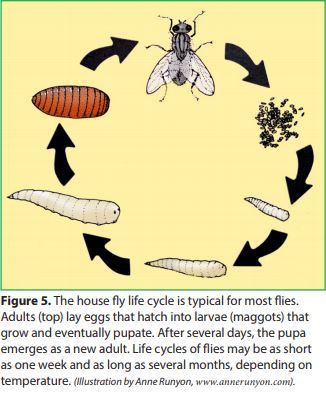
House flies
House flies (Family Muscidae) are outdoor flies that do not bite. They are generally not an important indoor pest unless doors or windows are poorly screened or frequently left open.
House flies breed in decaying organic matter such as livestock feces and garbage. They are active on warm days year around but reproduce most quickly in the summer. At 60 °F it takes a house fly about 45 days to go through its life cycle; at 95 °F that time is shortened to 7 days. Adult house flies live for up to three weeks.
House flies are not only a nuisance; they are thought to carry more than 100 diseases. Because house flies continuously deposit feces and regurgitate on surfaces, health departments consider their presence in restaurants or other food service businesses to be unsanitary.
House flies can migrate as far as 20 miles, but most stay within ½ to 1 mile of their breeding site. When house flies become a problem outside of a structure, look for nearby breeding sites including livestock or compost operations, improperly functioning latrines, and poorly maintained dumpsters or garbage cans. Household compost piles that are not properly managed may also become a source of house fly breeding.
Fly swatters are an effective control measure for the occasional household fly, though commercial restaurants and other sensitive commercial sites usually use insect light traps. In addition, automatic air curtains in doorways can help reduce fly infiltration at entryways to commercial facilities.
Soldier flies
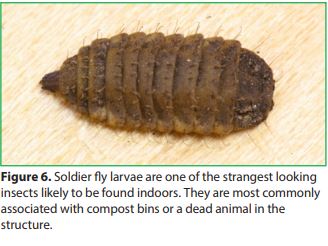
Soldier flies (Family Stratiomyidae) are outdoor flies that occasionally enter homes and buildings.Indoors, these flies are most commonly seen as full- grown larvae that have completed feeding and are searching for a place to develop (pupate) into an adult. During this wandering phase, soldier fly larvae may travel several yards from their breeding site, and may be seen wriggling along a floor, patio, or fireplace hearth. Soldier fly larvae are about 1 inch long, leg- less, grey to dark brown, and flattened. The “skin” is has a distinctive, leathery texture. Though not harmful, most people would consider the presence of these tough-skinned larvae indoors to be objectionable. Control involves finding and eliminating the food source. Breeding sites include rotting organic matter, such as spoiled grain, dead birds or other animals in an attic or chimney, or a decaying bee nest in a wall. Indoor worm compost bins have been known to harbor soldier flies.
The adult stage of the most common species of soldier fly is about 3/4 inch long and black, with a translucent segment on the tail (abdomen). Adult flies are sluggish until induced to fly, and are rarely noticed. They may be attracted to light but do not seem attracted to food.
Carrion flies
Carrion flies include flesh flies (Family Sarcophagidae) and blow flies (Family Calliphoridae). Immature stages of blow flies feed on decaying organic material—especially dead animals but also garbage, manure, or other rotting plant material. Blow fly larvae are creamy white and legless. Sometimes referred to as maggots, blow and flesh fly larvae are cylindrical and taper to a pointed head. The presence of these larvae in a home usually indicates that a bird, squirrel, rat, etc., has died somewhere in the structure.
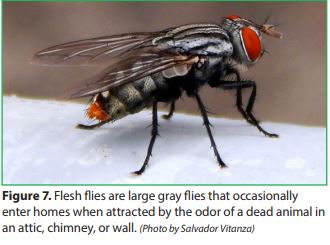
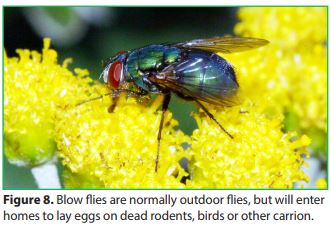
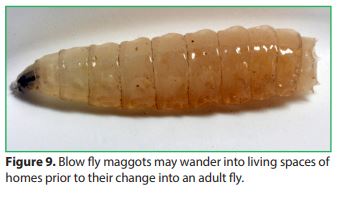
Maggots in homes are usually those that have completed feeding and are searching for a place complete their metamorphosis. Left undisturbed, they will pupate in a crack or other protected spot and emerge as an adult fly.
Adult blowflies are shiny blue or green and are 1/4 to 7/16 in long (6 to 11 mm). Flesh flies are large (3/8 to 5/8 in, 10 to 16 mm) and gray with black stripes on the thorax. The tip of the abdomen is red or pink in some species.
Adult blow and flesh flies are usually seen 1 to 2 weeks after maggots appear in a home. Flies may continue to emerge for 1 to 3 weeks, after which they should disappear. Ideally, you should remove any dead animal carcasses, though these are sometimes difficult to find or are out of reach. In most cases destroying any maggots and killing adult flies with a fly swatter is the only practical response to such fly infestations.
Blow flies and flesh flies indoors indicate a home that is poorly sealed against wildlife. The house should be inspected for any openings where birds or mammals might enter. These openings should be sealed with sturdy wire, sheet metal, or other pest-resistant material. Chimneys should be sealed with a chimney cap, and roof turbines and vents should be screened to exclude birds, bats, and other wildlife.
Control suggestions
Sanitation
The key any indoor fly problem is to find and eliminate the source, that is, anywhere excess moisture and organic debris may have accumulated. Moisture is critical for fly breeding. Fly larvae cannot breed without some source of water, so look for areas with moisture. Sanitation suggestions include:
- Find and clean up any spilled or spoiled food on floors or in pantries
- Clean sink and bathtub/shower drains
- Check under liners in garbage containers and, if necessary, use soap and water to remove all organic residues
- Clean under and around the floor drain covers—especially in commercial buildings
- Clean under foam floor mats in commercial kitchens
- Hang mops off the floor to encourage drying— do not store dirty mops
- Inspect and clean under and around the feet of refrigerators or other kitchen equipment where organic matter collects
- Check and clean condensate lines and trays associated with refrigerators and icemakers
- Look for cracked or loose ceramic floor or bath tiles that could hide bacterial films
- Check for signs of rodents or other wildlife that might indicate the presence of a dead animal— seal any potential animal entry points
Drain and septic treatment
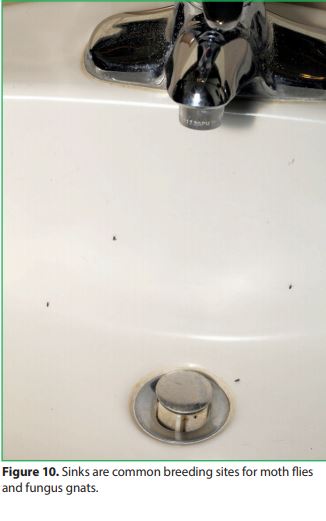
To check whether a drain is breeding site, place a length of clear packing tape across the drain without totally covering the opening. If you cover the opening completely, there will be no airflow and flies may not emerge. Check the tape periodically. If you see flies stuck to the tape, you have found a source of infestation.
After locating the sources, drains must be cleaned to eliminate any bacterial film inside the plumbing. Chlorine bleach or drain cleaner is largely ineffective at removing such films. To eliminate these breeding sites, you must clean the pipes and traps with a stiff brush. After scrubbing, flush the lines with hot to boiling water to remove any material left in them.
An alternative to scrubbing is to use an antibacterial drain product designed to biodegrade organic films. These drain treatments usually require repeat applications over several weeks to eliminate the bacterial films. If you have a septic system, make sure any drain cleaning product you use is compatible with your system.
Most insecticides are not labeled for use in drains; however, S-hydroprene (Gentrol) can be used in drains as a spray or foam. It may also be applied to other areas that are not easily cleaned. Hydroprene is a low-toxicity insect growth regulator that disrupts the fly’s life cycle. This product does not kill adult flies, but it does prevent larvae from completing their development.
Traps
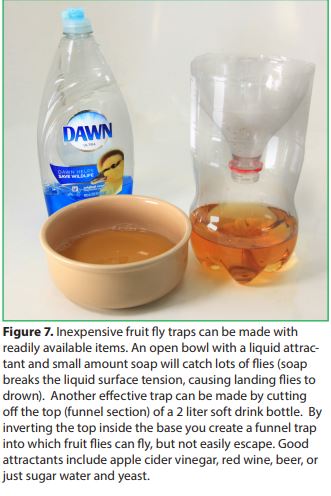
Light traps take advantage of a fly’s attraction to short wavelength light (ultraviolet, or UV) to draw them to a glue board or low voltage electric grid. They are most effective for larger flies, like house flies, but may also trap small flies and other flying insects. Light traps should be installed 4 to 6 feet above the floor, which is the typical flying height for house flies. Because lights can attract flies from a distance, they should be mounted so they are not visible from the outdoors. Most light trap manufacturers recommend that the bulbs be replaced annually because UV output of fluorescent tubes degrades over time. High voltage, outdoor “bug zappers” should not be used indoors because they tend to scatter insect fragments and can contaminate the indoors.
Baited traps are frequently used for fruit flies and, occasionally, for other flying insects. Though bait traps alone rarely provide adequate fly control, they can help pinpoint the source of a fly problem, monitor the success of control program, or help reduce fly numbers as you find and eliminate breeding sites. Traps can be as simple as a plastic bowl containing an attractant, like apple cider vinegar, and a few drops of soap to drown flies that attempt to land on the solution. They can also be commercial traps with funnels or small entry ports that make escape difficult.
In natural settings, fruit flies are attracted to fermenting fruits. Suitable attractants for traps include apple cider vinegar, wine, bananas, orange slices, apple cider, etc. You can add a small amount of yeast to the trap material to increase its attractiveness; however, the odor of fermenting baits may be objectionable indoors. These types of baits may need to be replaced every few days. Some commercial traps use low odor lures that can last as long as a week. Such traps can capture large numbers of fruit flies.
Insecticides for fly control
Once the fly-breeding areas are cleaned or eliminated, you should not need to use insecticides. However, insecticides are sometimes helpful to knock down remaining adult flies, or to help control flies that come in from other locations.
Pyrethrin aerosol sprays, or other “flying insect” sprays, can provide temporary control of adult flies indoors. For outdoor fly problems, a residual insecticide labeled for outdoor fly control can be applied to fly resting sites. When mosquitoes or house flies are common outdoors, spray door entryways with one of these insecticides to reduce the number of flies that enter the house with human traffic. Be sure to follow label directions carefully, as many insecticide labels now prohibit spraying pavement, surfaces exposed to rain, or surfaces that drain onto pavement. The goal of these precautions is to prevent insecticides from being washed into streams or storm drains.
In some cases, commercial baits are available for controlling house flies. Bait formulations include products that can be used in bait stations or applied as a liquid or slurry to areas where flies land. Some baits can be toxic to pets or livestock, so follow label safety precautions.
Download a printer-friendly version of this publication: Indoor Flies and Their Control
